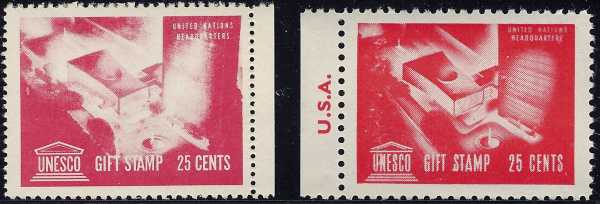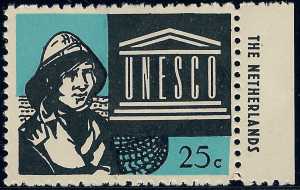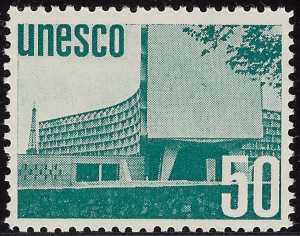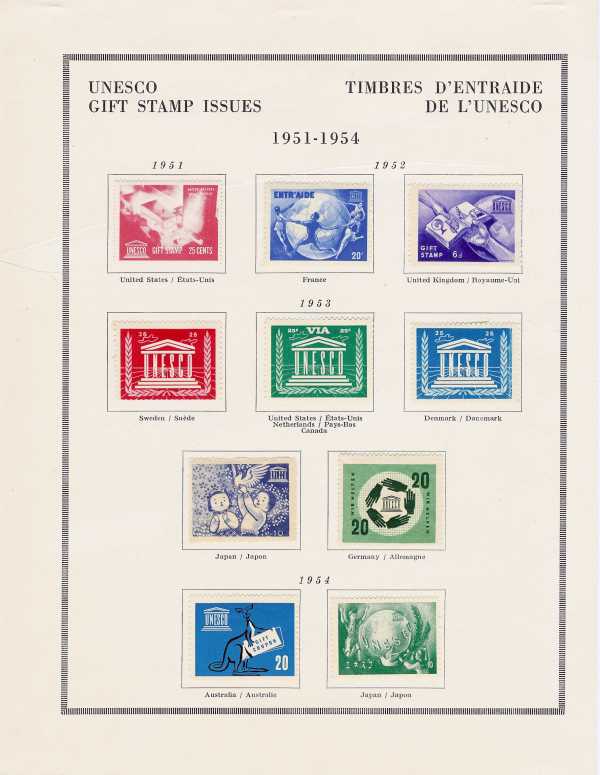UNESCO Gift Stamps
by Bonnie & Roger Riga
In the fifties and sixties, UNESCO - founded at the end of the Second World War to assist in the reconstruction of schools and libraries - issued what they termed "gift stamps" to raise funds for general revenue and a special book fund. Initially sold in schools at 25 cents each - or the national equivalent, the stamps came in a variety of designs and colors. The first stamp issued came in 1951, the same year that UN stamps began issue, and depicted the UN headquarters in New York. It bore the inscription "USA" and was red.
fig. 1: First UNESCO gift stamp for U.S.A. issued in
1951 with blank tab and reissued 1954 with country name on tab.
The next two gift stamps were issued in 1952. One in blue inscribed "Entr'aide"(Helping One Another) showed children, hands joined, dancing around the globe. This was to be sold in France. A stamp in purple for the United Kingdom, but used in Australia to begin with, showed a book bearing symbols of learning being handed from one person to another. All UNESCO stamps were in booklet form, each pane of ten stamps assembled with other panes of different values into a booklet of 4 to 18 different panes.
In 1953, five new stamps were issued. A combined U.S. and Canada stamp, the Sweden stamp and the Denmark stamp all showed the UNESCO symbol. The stamp for Japan showed two children and the dove of peace on a field of flowers. The German stamp depicted a circle of hands reaching for one another and the words "Wir Helfen" (we help).
fig. 2: The scarcest UNESCO gift stamps were issued
for The Netherlands in 1958 honoring help to shipwrecked sailors. 
An International Booklet was issued in 1954, containing 8 panes - one from each of the countries - and each stamp had the country name in the selvedge of the stamp. The only way to differentiate these reissued stamps from the original is by having both copies with the selvedge, since color differences are negligible. A new design for the Japanese stamp was included and an Australian stamp showing a kangaroo was issued.
Another International Booklet was issued in 1955 and again, differences are small. The denomination on the Australian stamp was changed from 20 to 6d, and "Netherlands" was added to the selvedge inscription on the U.S.-Canada stamp. Between 1955 and 1958 four more designs were issued including two for the Netherlands in blue and in orange showing a seaman and his ship. The Netherlands stamps sold out very quickly and were not reprinted. They are the scarcest of the UNESCO stamps. The others, numbering some 41 stamps in all (the last issued in 1966), were available through UNESCO until late in the 1960's or longer.
fig. 3: A 1959 gift stamp depicting the UNESCO
headquarters in Paris. This is the only gift stamp design using a photographic image.
fig. 4: This 1961 stamp honored UNESCO
work camps that focused on the production of adobe bricks for use in the construction of
low cost housing.
As with any stamp, what began as a fund-raising coupon became a collectible. Folders and album pages containing places for the stamps and an accompanying write-up was produced and sold. This too went through some changes and as many as four or five different styles are known. Variations seem to reflect the stamps that were available from UNESCO at a given time, ignoring varieties and unavailable issues.
The gift stamps are a piece of United Nations -UNESCO philatelic history. While they had no postal validity and are little known, even to the United Nations collector, these stamps are a nice collateral collection for the specialist. The number of stamps is small enough, yet varied enough to present a challenge and the ever- wonderful joy of the hunt.
fig.5: Album page folder for
face-different UNESCO gift stamps issued from 1951 to 1954.
This column first appeared in Scott Stamp Monthly and has been edited for online presentation.
This page was last updated July 9, 2016.
Copyright © 1997-2016 by Rigastamps.All rights reserved.